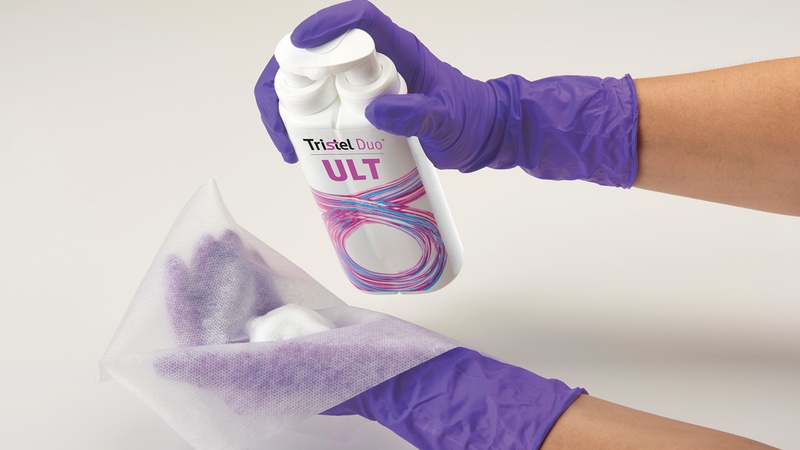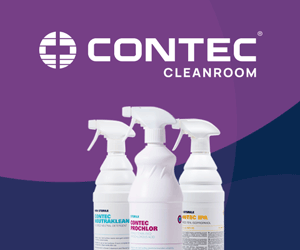Backed by a financial report that shows 13 years of growth at a compound annual rate of 17%, Paul Swinney, Tristel CEO, met with private shareholders to give an update on the business. Cleanroom Technology was the only media present at the event held in July at the company's headquarters in Snailwell, near Cambridge.
The British manufacturer of disinfection products reported a turnover of £22.2 million for the fiscal year that ended 30 June 2018; overseas sales rocketed 19% to £1.8 million in this period. Swinney said trade to international markets now represents 51.3% of total group sales.
Swinney seemed bullish on the outlook of the business: “We have had £6.7 million in cash in the bank as of 30 June 2018, and we have no debt,” he said in answer to a question from the audience. Besides the healthy financials, the fuel in his optimism is twofold: the company is one step closer to entering the United States and the product innovation plan to get a larger share in the infection prevention and contamination control markets are bearing fruit.
Tristel has invested £1.3 million over the past four years in a United States programme to gain governmental approvals to enter the market with Duo, a proprietary chlorine dioxide solution in a foam. The product, designed specifically for the high-level disinfection of endocavity ultrasound probes, received the green light from the Environmental Protection Agency (EPA) and a successful registration was announced in April this year. Federal registration is moving forward on a state-by-state basis. Filings have been made for five States and Tristel expects to complete the process by the end of 2018. The company is also well positioned to add a second foam-based product format to its registration.
Strategic partnership
Tristel Duo is branded Jet in the UK and overseas markets yet it utilises the same chemistry. Manufacturing scale-up for the US is underway at Parker Laboratories, the company that Tristel teamed up with in March this year. The partnership is another strategic move by the British firm, to expand its presence not only in the US but also across the American market.
Parker Labs, a family-owned company, was established more than three decades ago when ultrasound was being developed as a medical technology. Swinney told shareholders that Parker’s founder was the first person to create a conductive gel that enhances the ultrasound image, which is the method still in use today.
Based in Fairfield, New Jersey, Parker Labs is registered with the FDA as a manufacturer of medical devices; it is both a manufacturer and sales representative of accessories and supplies for the ultrasound and electromedical markets. Its product portfolio is manufactured in a 95,000 sq ft facility and is available globally. The company has nationwide distribution through a network of approximately 500 distributors. Parker is also known as a market leader in the ultrasound market in Canada and throughout Central and South America.
Market penetration
What has paved the way for Tristel to tell such a success story to its shareholders is down to its chemistry, which it holds as a well-kept secret. Tristel has various patented chlorine dioxide formulas, including soaking solutions and sprays. Key patents lie in the use of the chemistry in a wipe and in a foam format.
New product development is yet another decisive factor in Tristel’s business. The way in which the company has been able to incorporate the chemistry into wipes and foams to disinfect medical instruments is unique.

US focus: Tristel Duo is branded Jet in the UK and overseas markets yet it utilises the same chemistry
Tristel’s wipes and foam products are branded Trio and Duo, respectively, and their sales represented 74% of all its chlorine dioxide sales in 2018, and 66% of the company’s worldwide sales. "Trio and Duo are truly unique, not only in that they use chlorine dioxide, but that they are recognised by regulatory bodies worldwide as high-level disinfectants and they are used manually," Swinney explained.
Other products in the high-level disinfection market for medical instruments are used in the form of a liquid for soaking, or in a gaseous or vapour form, and can only be used in a machine that protects the user from the disinfectant.
Our competitors sell the machines their chemicals are used in, as well as the chemical. Our products, on the other hand, are applied manually; and we only sell consumable chemicals.
Infection control in hospitals is the primary focus of Tristel’s business today; 89% of its revenues come from this sector. Tristel delivers solutions for contamination control in the pharmaceutical and personal care industry under the Crystel brand and it makes a product line for the veterinary market under the Anistel brand. The combined sales from these brands were £2.4 million in 2018, 11% of all sales in this period; mostly in the UK.
The challenge now, Swinney said, is to replicate the penetration achieved in the UK in multiple markets overseas; this is one of four targets the company wants to achieve by 2019. The strategic growth plan also includes the expansion of the global footprint of the business, find new clinical areas to target and extend the reach into surface disinfection to enable chlorine dioxide to be used in a far larger marketplace, globally.
Tristel’s partnership with Israeli tech company Mobile ODT is part of the strategy to target new clinical areas that could open market opportunities. The company has developed a software to use with a mobile phone to create a colposcope for cervical examinations and Tristel has created a Duo version for the disinfection of colposcopes, called Eve, which will be co-marketing with Mobile ODT around the world.
Both companies have joined forces to achieve something that no other disinfectant manufacturer is doing today: embedding the disinfection process in an app. “They created an app to use with mobile phones, take a picture to capture the image of the cervix and store it in the cloud for remote diagnosis. This is a terrific opportunity,” Swinney explained.
Product innovation is another key driver in the plan to extend the company’s reach into surface disinfection and Swinney explained what’s in the pipeline: “The innovation involves developing a capsule that holds our two chemicals separately that can then burst into a bottle or water source; we have created the disinfectant, which can now be applied by staff onto a dry wipe for dispersal, and we’ve got patents around it.” This innovation, Swinney said, will hit the market soon.




